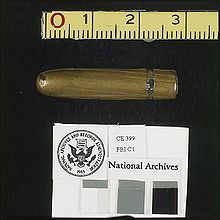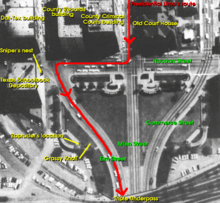Single bullet theory
The single bullet theory ("one ball theory"), also known as the magic bullet theory (Eng. "Theory of the magic ball"), says that a single bullet on November 22, 1963 when John F. Kennedy punctured the bodies of both the President and the Governor of Texas , John Connally , causing a total of seven wounds (entry and exit). This Warren Commission's claim is considered extremely implausible by those who believe that Kennedy was the victim of a murder plot. They follow the arguments of prosecutor Jim Garrison in the 1967 trial against Clay Shaw .
Theory
On November 22, 1963, the limousine drove from Dallas Airport with President John F. Kennedy, his wife Jackie Kennedy , Texas Governor John Connally, his wife, bodyguard Roy Kellerman and chauffeur and secret service agent William Greer Love Field through downtown to the Dallas Trade Mart, where Kennedy wanted to give a speech. As the limousine drove towards the underpass on Elm Street, various shots rang out. Lee Harvey Oswald reportedly fired at least three shots from the fifth floor window of the Texas School Book Depository. The first shot allegedly missed, but the second hit and caused seven injuries to Kennedy and Connally according to the Magic Bullet theory.
Old illustration
The bullet caused seven injuries: it came from behind and above, first penetrated Kennedy's neck, then penetrated Connally's upper body, then his wrist and then got stuck in his thigh. It is criticized that with this trajectory the ball should have made several turns. It would also not be possible for the ball to have been deflected in exactly the same way by individual body parts or other objects in the vehicle and also to have survived this undamaged.
New representation
New representations get by without the theory of a deflected sphere. Various corrections have been made to the theory:
- It was assumed that Connally and Kennedy were seated on the same level. But Connally sat on a fold-out seat that was about two inches lower than the president's seat.
- It was also believed that Connally was sitting right in front of Kennedy. But the jump seat that Connally was sitting on was about four inches from the car door.
- In addition, it should be noted that Connally had turned to the right rear at the exact moment the shot was fired.
So if you look at all the injuries, you get a straight line through the injuries and up to the launch window on the sixth floor. Minor deviations are possible due to the reconstruction at the time, but these are covered again by the possibility of small deflections of the shot.
Exit wound
The theory was later heavily criticized. Among other things, the missing exit wound was brought up in the field: although a bullet hole had been found on the neck, but no exit hole in the front of the neck. This could be explained by the fact that the doctors at Parkland Memorial Hospital made an incision in the trachea - to save the President's life - and a possible exit wound was no longer visible as a result. However, this contradicts the fact that the Parkland Hospital doctors discovered a gunshot wound there before the trachea incision, but not an exit wound, but an entry wound.
The claim that it was an entry wound comes mainly from Malcolm Oliver Perry 2nd (1929-2009) - one of the doctors - from the Parkland Memorial Hospital, who believed he recognized a contusion ring . At this point, before the tracheotomy, Perry was still fighting for Kennedy's life, so it is very likely that it is only a superficial observation.
A contusion ring is created as a projection of the temporary wound cavity on the skin. The temporary wound cavity forms because the bullet also emits its energy radially after impact and accordingly displaces the tissue. The temporary wound cavity is thus larger than the projectile itself. Since the projectile destroys the skin up to its size, the destruction of the tissue is greater than the destruction of the skin. This shows up as a contusion ring.
The temporary wound cavity will vary in size depending on the caliber and propellant charge, but it will always be shorter than the primary wound cavity created by the penetration of the bullet. Thus, temporary wound cavities and thus also contusion rings always show up in bullet wounds. The claim that they only arise from bullet wounds, however, is wrong.
The shot only penetrated Kennedy's neck. With such a shallow tissue depth, the temporary wound cavity extends completely through the tissue. Now, due to the tearing open of the skin, no contusion ring usually forms there. Unless the skin has a firm abutment that prevents the skin from tearing open. In this case, so-called pseudo-contusion rings arise in the case of exit wounds.
The wound on Kennedy's throat was exactly at the knot of his tie. The bullet cut the tie itself. This means that the likelihood that Perry saw a pseudo-contusion ring and mistakenly thought the wound was a bullet wound is very high.
Sagittarius
According to the investigation at the time, the shooter is Lee Harvey Oswald. But various critics are of the opinion that he was only the victim of a major plot . Three cases from Oswald's rifle were found at the launch window, but they could also have been placed there by someone else. Against this is the fact that when Oswald came to work (he worked in the School Book Depository), he had a bag with an elongated object. When asked what it was, he replied " a curtain rod to hang up the new curtains ." However, such a curtain rod was never found in the School Book Depository.
Web links
- The Single Bullet Theory on the website of the American political scientist John McAdams






